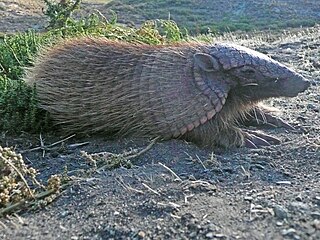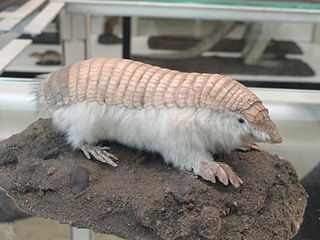Hairy armadillo may refer to:
- Andean hairy armadillo (Chaetophractus nationi), present in Bolivia
- Big hairy armadillo (Chaetophractus villosus), one of the largest and most numerous armadillos in southern South America
- Hairy long-nosed armadillo (Dasypus pilosus), in the family Dasypodidae; endemic to Peru
- Screaming hairy armadillo (Chaetophractus vellerosus), a burrowing armadillo found in the central and southern parts of South America

The Andean hairy armadillo is an armadillo located in Bolivia, in the region of the Puna; the departments of Oruro, La Paz, and Cochabamba. Nowark (1991) describes it as distributed in Bolivia and northern Chile. A recent publication of Pacheco (1995) also locates the species in Peru, basically in Puno Region. This species is also thought to be present in northern Argentina. However, this location may actually only contain a population of C. vellerosus.

The big hairy armadillo or large hairy armadillo is one of the largest and most numerous armadillos in South America. It lives from sea level to altitudes of up to 1,300 meters across the southern portion of South America, and can be found in grasslands, forests, and savannahs, and has even started claiming agricultural areas as its home. It is an accomplished digger and spends most of its time below ground. It makes both temporary and long-term burrows, depending on its food source. The armadillo can use specially evolved membranes in its nose to obtain oxygen from the surrounding soil particles without inhaling any of the soil itself. Armadillos are protected from predators by a series of thin, bony plates along the head and back. They reach sexual maturity at around 9 months and have been known to live over 30 years in captivity. Though this animal is routinely harvested for its meat and its shell, or simply killed for pestering farmers, it has shown amazing resiliency, and populations seem to be handling this exploitation well. Currently, no protective practices are in place for this armadillo, but it does live in many protected areas. This species of armadillo is a preferred research animal due to its adaptability to laboratory settings, and relative hardiness in situations of stress.

The hairy long-nosed armadillo, or woolly armadillo, is a species of armadillo in the family Dasypodidae. It is endemic to Peru. Its natural habitats are subtropical or tropical moist lowland forest and subtropical or tropical moist montane forest. The International Union for Conservation of Nature used to consider it a "vulnerable species" but has changed this assessment to "data deficient" because so little is known about the animal and the threats it faces.
| This disambiguation page lists articles associated with the title Hairy armadillo. If an internal link led you here, you may wish to change the link to point directly to the intended article. |










